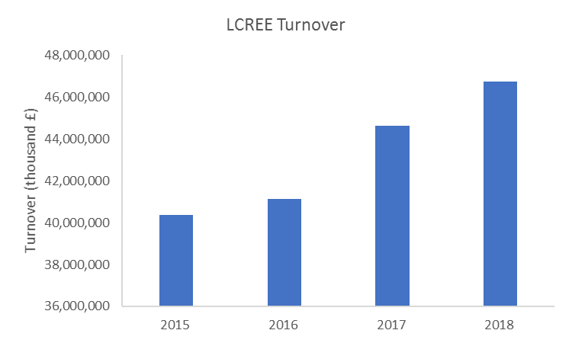Last year, in pursuit of efforts to limit global warming to 1.5˚C, the UK became the first major economy to legally mandate to cut greenhouse gas emissions to net-zero by 2050. This is a key step to tackling climate change but even aside from the environmental benefits that will come from driving down emissions, there are key opportunities for the UK. Meeting the target will require an overhaul of many areas of the economy, opening the door to new green industries with accompanying jobs within a short period of time.
Prior to the new goal, the Government had agreed to cut emissions by 80% compared to 1990 levels, under the Climate Change Act of 2008. The green economy has already begun to grow as industries moved towards reaching this, with momentum in recent years as the climate emergency has become more apparent. New data released from the UK’s Office of National Statistics (ONS), based on a survey of 24,000 businesses, reveals that the UK’s low carbon and renewable energy economy (LCREE) has grown by 16%, reaching a turnover of £46.7 billion in just three years. The LCREE includes sectors such as low emission vehicles and offshore wind, that contribute towards the UK generating lower emissions of greenhouse gases, predominantly carbon dioxide.

Figure 1: UK’s low carbon and renewable energy economy turnover, 2015 – 2018 (ONS)
Employment in the green economy has also risen by 12% since 2015, growing to 224,800 jobs (full-time equivalent). These figures account for 1% of the UK’s turnover and employment.
How do these numbers translate?
The largest sub-sector, now accounting for 36% of turnover (£16.7 billion) and 51% of employment, is the energy-efficient products sector which designs, manufactures and installs products including energy-efficiency doors, windows, insulation, heating and ventilation. Following behind with a turnover of over £4 billion is the low emissions vehicles and infrastructure, designing technology such as electric or hybrid vehicles to specifically reduce or remove emissions. This sector also accounted for £3.1 billion of exports. Levels of investment in the green economy have also grown by 47% since 2015, with businesses acquiring £8.1 billion of capital assets in 2018, almost half of which came from the offshore wind sector.

Figure 2: UK’s low carbon and renewable energy economy turnover by sector, 2018 (ONS)
Public Response
Whilst this new data provides a positive outlook, some have responded with scrutiny after drawing comparisons from data in a previous survey conducted in 2014. The ONS has warned specifically against these comparisons, advising that changes in the sampling methodology could distort the results. Despite this, critics have argued that although figures confirm that turnover has grown, lower levels of employment in the 2014 data imply the green economy is instead shrinking. However, changes in employment are mainly in the solar sector following the removal of subsidies for renewable energy, and do not reflect the green economy overall.
Outlook for the future
The recent growth in the green economy will only gain momentum now that reaching net zero by 2050 has been put into law. If growth continues at the rate demonstrated by the ONS so far, which averaged at 5% annually since 2015, the green economy’s turnover could reach over £200 million by 2050 and create a significant number of jobs in the next 30 years.
The National Grid has recently investigated this growth in the workforce and found that the energy sector must recruit for 400,000 jobs by 2050 to reach net zero. This number is split into 260,000 new roles, and 140,000 to replace those who leave the workforce with most roles focusing on building and upgrading energy infrastructure at a large scale. In more recent terms, it was found that 117,000 jobs will need to be filled in the energy sector within the next 10 years, particularly for engineers with renewable expertise and in data analytics to forecast energy demand.
Overall, this data from both the ONS and National Grid reiterates the upward trend that the green economy is experiencing and outlines how the pathway to net zero may translate into employment across the UK economy.
For more information please contact Christina Thompson-Yates
christina.thompson-yates@gemserv.com
References:
[1] Low carbon and renewable energy economy, UK: 2018 – Office for National Statistics (2020)
[2] Building the Net Zero Energy Workforce – National Grid (2020)

